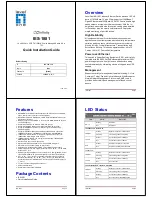
(Revised 2012-06-30) page 24 of 165
DHCP Client
The switch will automatically obtain an IP assignment from a DHCP Server, or optionally Fallback to a
configured IP assignment if unable to get an IP assignment from a DHCP server. Communication between
the client and server can optionally go through a DHCP Relay Agent.
DHCP Relay Agent
DHCP Relay Agent (Option 82) allows communication between the client and server to cross subnet and
VLAN boundaries. It also allows for a device on a specific port to receive a specific IP address and if the
device is replaced, the replacement receives the same IP address as the original device.
DHCP Server
DHCP Server allows DHCP Client devices to automatically obtain an IP assignment. IP assignments can be
set up as a dynamic range of IP addresses available to any client device; or specific IP addresses based on
the clients MAC address, Client ID (Option 61), or Relay Agent connection (Option 82).
LLDP
Link Layer Discovery Protocol (LLDP) is a Layer 2 discovery protocol allowing devices attached to an
IEEE802 LAN to advertise their major capabilities to other devices and to store information they discover in
a MIB that can be accessed through SNMP. LLDP is formally described in IEEE Standard - 802.1AB.
Port Security—MAC Address Based
The Port Security feature restricts access to the switch by only accepting dynamically learned MAC
addresses and manually entered MAC addresses as authorized. Dynamically learned MAC addresses are
those that the switch detects on any port while in ‘Learning’ mode. A manually entered MAC address must
designate the ports that the address is authorized on. A non-authorized MAC address will be discarded and
will be shown on the intruder log. Locking can be selected or not port by port.
XML Settings Download
XML settings can be downloaded to a switch to achieve some switch configurations. XML settings cover a
subset of the settings available through the web browser. Reference
Appendix A. XML Settings File Example
for the complete set of configurations that can be done using XML Settings Download. There are several top
level configuration sections and each of these sections is optional. Some sections have a ‘keep or delete’
choice such that one can load only those in the XML file deleting the pre-existing of those particular settings
or one can add the settings in the XML file to the already existing settings. The example also shows field
character limits, and provides other guidance.
Rate Limiting
Some systems generate a large amount of broadcast or multicast traffic occasionally. When it happens, the
entire network may experience failures that persist until there is manual intervention. One way to address
this problem is to control the broadcast or multicast traffic to remain below a user configured maximum
limit. The most effective limit may be best obtained in test. Thus the user is provided with the capability to
‘tune’ the limit by switch port. These are ingress filters. The percentage values are repeatable to the purpose
and rise or fall as compared to each other, but are not meant to be as exact as in a piece of calibrated test
equipment.
Summary of Contents for 7900 Series
Page 37: ... Revised 2012 06 30 page 37 of 165 DHCP Server Setup Profiles Continued ...
Page 40: ... Revised 2012 06 30 page 40 of 165 DHCP Server Setup IP Maps Continued ...
Page 46: ... Revised 2012 06 30 page 46 of 165 DHCP Relay Local IP Setup Continued ...
Page 52: ... Revised 2012 06 30 page 52 of 165 Ports Configuration Continued ...
Page 88: ... Revised 2012 06 30 page 88 of 165 IGMP RFilter Continued Modifying rfilter port settings ...
Page 96: ... Revised 2012 06 30 page 96 of 165 ...
Page 124: ... Revised 2012 06 30 page 124 of 165 If a Configuration Device is present that is presented ...
















































